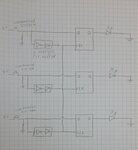Lironsh
Newbie level 5

- Joined
- Oct 19, 2013
- Messages
- 10
- Helped
- 0
- Reputation
- 0
- Reaction score
- 0
- Trophy points
- 1
- Activity points
- 100
Hello all,
Is there a chip which includes a D FlipFlop and also a DELAYED Clock? I want to press a button and at the same time turn on an LED on the output.
My solution so far is to use a 74x175 DFF and two inverters in series from 4069 chip for the clock so i can get my t_setup on time in one press.
Anyone knows one chip for that?
Thanks,
Liron.
Is there a chip which includes a D FlipFlop and also a DELAYED Clock? I want to press a button and at the same time turn on an LED on the output.
My solution so far is to use a 74x175 DFF and two inverters in series from 4069 chip for the clock so i can get my t_setup on time in one press.
Anyone knows one chip for that?
Thanks,
Liron.



